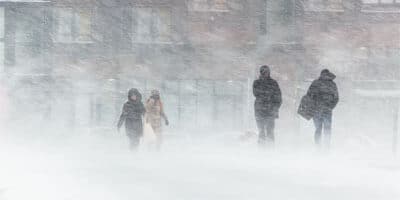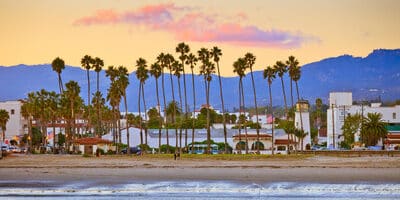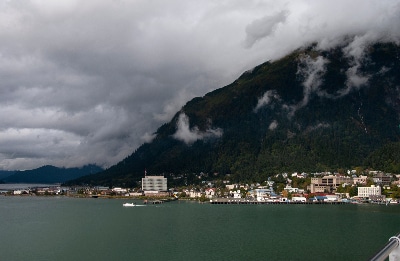
Have you ever wondered what is the cloudiest city in the United States? Perhaps you’re tired of staring up at slate gray skies day after day, and you’re curious if anyone else possibly has it worse. Maybe you’re looking for a sunny vacation spot and want to know which places to avoid. Perhaps you’re just curious. Either way, we have your answer in this article!
For this list, we examined cloud cover in cities with a population of over 25,000. If your gloomy but small town doesn’t appear on our list, that might be why! We used data from NOAA’s National Centers for Environmental Information which keeps track of weather and climate data for cities across the United States. Helpfully, this data goes back many years, and we examine long-term averages so we can make a reliable and accurate comparison.
We’ve ranked the cloudiest cities here by number of “cloudy days,” defined as days when clouds cover more than 80% of the sky during daylight hours. We’ve also listed the number of partly cloudy days when clouds cover between 30 and 80 percent of the sky during daylight hours.
In the case of a tie for the number of cloudy days, the city with more partly cloudy days (and fewer “clear” days) ranks higher. This isn’t a perfect metric. After all, if the 10% of the sky free from clouds happens to be right in front of the sun, maybe you’d consider it to be a sunny day! But the fraction of sky covered by clouds has been reported for many years allowing us to make solid long-term comparisons between cities.
The 11 Cloudiest Cities in the United States
Now that you know how we’re ranking cities, let’s look at our list of the gloomiest cities! Here are the eleven most cloudy cities in the US (with a population over 25,000) according to cloudiness data from NOAA’s National Centers for Environmental Information (NCEI).
1. Juneau, Alaska
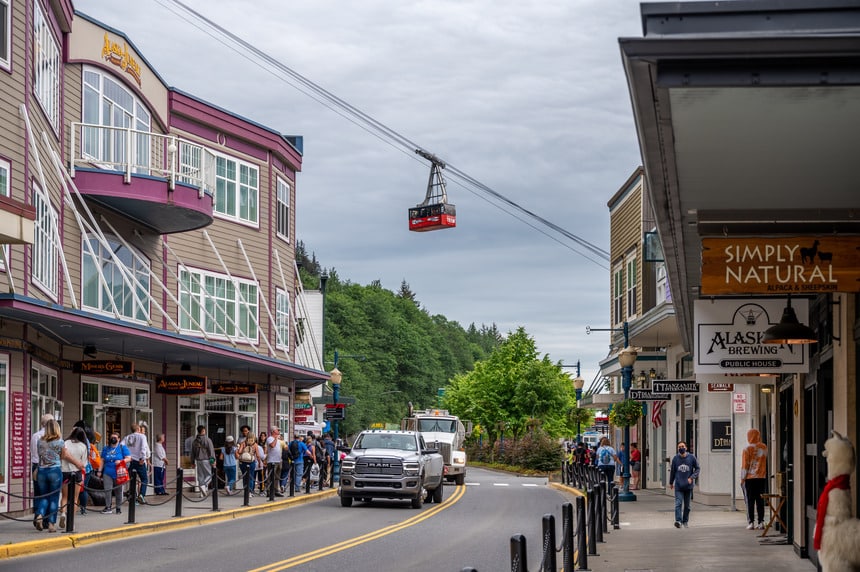
- Cloudy Days: 280
- Partly Cloudy Days: 41
- Clear Days: 44
- Average Annual Temperature: 42.1°F
- Average Annual Number of 32°F or Lower Days: 136
- Average Annual Precipitation: 62.27 inches
Juneau, Alaska, is the cloudiest city in the US, with 280 days, more than three-quarters of the year, spent under gray skies. Of the remaining days, 41 are at least partly cloudy, which leaves just 44 days of pure sunshine.
Why is it so cloudy in Juneau? The city sits near the northeasternmost corner of the Pacific Ocean. Prevailing winds in Juneau are westerly or southwesterly, which means the wind usually comes in from off the water. The Pacific is the world’s largest ocean, so air passing across it has plenty of time to pick up moisture before it arrives in Juneau.
Once that air shows up in Juneau, one (or both) of two things can occur to produce clouds. To make a cloud, you need some air with moisture, and then you need to make that air cold enough that some of that moisture condenses into little water droplets that form clouds.
One way that Juneau commonly gets clouds is when the air coming from the warmer central Pacific (near Hawaii) passes over the current of very cold water that runs from Alaska down to California. When the warm, moist air hits the cold water, some of its moisture must condense into cloud droplets. That nearby cold water also helps to hold Juneau’s temperature down, especially during the summer, which is why the city is the sixth coldest city in America!
Another way to get cloudiness in Juneau is when the air coming off the Pacific hits the nearby mountains. As air rises, it cools, and when it cools, some of its moisture condenses into clouds. While the warm-air-over-cold-water process is good at producing cloudiness, the warm-air-hitting-mountains process is also good at producing rain and—if the temperature is cold enough—snow. That’s why Juneau is the second rainiest city and second snowiest city in America!
Between the clouds, the rain, the snow, and the cold, if you like sitting inside by the fire while it’s gloomy outside, there is no better city in America than Juneau, Alaska. Despite being the cloudiest city in the United States, most of Juneau’s tourist attractions are outside. Without leaving Juneau’s city limits, you can visit the Mendenhall Glacier, watch icebergs float by at Tracy Arm, and catch a glimpse of Grizzly Bears in the Tongass National Forest. If you don’t want to venture into the elements, the Alaska State Museum provides a great indoor option for learning about Alaska’s history.
2. Anchorage, Alaska
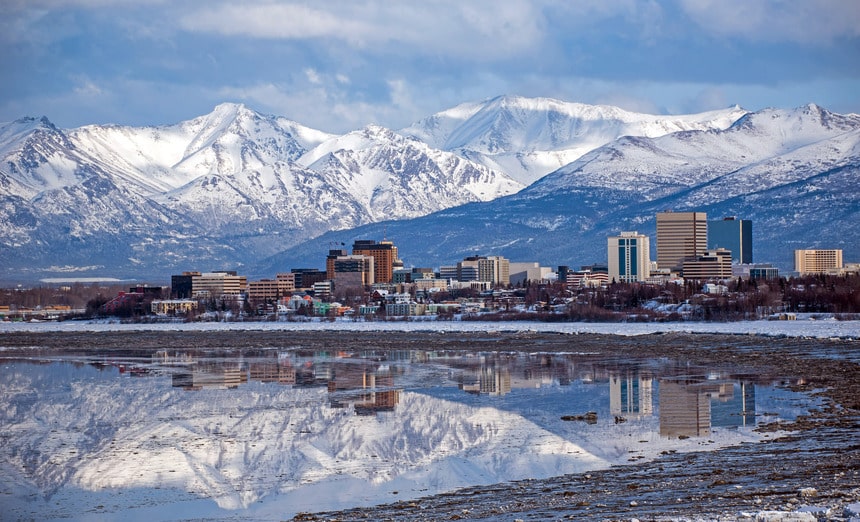
- Cloudy Days: 239
- Partly Cloudy Days: 65
- Clear Days: 61
- Average Annual Temperature: 37.0°F
- Average Annual Number of 32°F or Lower Days: 191
- Average Annual Precipitation: 16.58 inches
Nearly 600 miles up the coast from Juneau, but still a modest stone’s throw from the Gulf of Alaska, sits Anchorage, our second-cloudiest city. Despite also being near cold water and towering mountains, Anchorage records 41 fewer cloudy days than Juneau in an average year. Why is that?
Nestled right at the northernmost point of the Gulf of Alaska, Anchorage sits at the end of a long bay flanked on three sides by mountains. That means that unless the wind is blowing from the southwest, straight up the bay, it will be forced to descend before arriving in Anchorage. Remember that rising air cools and (often) makes clouds. The opposite is true for descending air which warms and dries. While Juneau only has one wind direction that offers a chance for downsloping (northeast), Anchorage has three.
Why is Anchorage cloudy enough to earn the number two spot, then? You guessed it—by far, the most common wind direction in Anchorage is from the southwest, the perfect way for Pacific air to move up the bay and form clouds. That cool, damp, cloudy onshore breeze is one reason Anchorage is the second-coldest city in the United States, only behind Fairbanks. Anchorage doesn’t quite get the precipitation needed to make it onto our list of the top rainiest or snowiest cities. That said, it’s still plenty cool and dreary if that’s your thing.
Much like Anchorage, Juneau’s attractions are primarily its nearby mountains and the opportunities for adventure that they provide. Chugach State Park is located within Anchorage’s city limits, while Kenai Fjords National Park is just a short drive away. If you’re looking for an indoor attraction, the Alaska Native Heritage Center provides a fantastic way to learn about the rich history and culture of Alaska’s native tribes.
3. Olympia, Washington
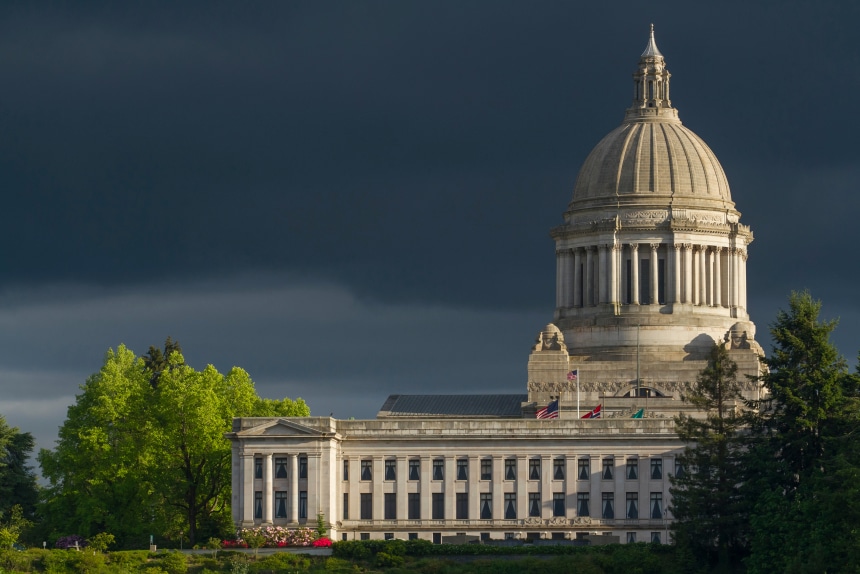
- Cloudy Days: 228
- Partly Cloudy Days: 84
- Clear Days: 53
- Average Annual Temperature: 50.5°F
- Average Annual Number of 32°F or Lower Days: 82
- Average Annual Precipitation: 50.00 inches
Also on the Pacific coast, just a bit farther south, sits Olympia, Washington, which records a respectable 228 days of overcast each year on average. The same forces that help produce abundant cloudiness in coastal Alaska also contribute to Puget Sound’s notorious gloom. The current of cold water that helps Alaska experience thick cloud cover by condensing the moisture carried by warm air that encounters it also runs past western Washington. The Pacific Ocean stretches thousands of miles west of Olympia, and prevailing winds are from the west, so there’s rarely any shortage of moisture.
The presence of mountains nearby, both the Olympic Mountains to the northwest and the Cascade Mountains to the east, also helps wring moisture out of the air in the form of clouds and, quite often, rain. In fact, Olympia is the sixth-rainiest city in the country! The mountains shelter Olympia from wintertime cold snaps enough that it doesn’t make our list of coldest cities in the US. Only 82 days on average each year see temperatures fall below freezing. Compare that to Anchorage, which spends more than half the year below freezing. That said, if you’re looking for gray skies and frequent drizzle without leaving the confines of the Lower 48, Olympia is a fine choice.
Olympia is most well-known for being home to The Washington State Capitol and the Billy Frank Jr. Nisqually National Wildlife Refuge, which is frequented by over 200 bird species providing excellent birding opportunities.
4. Seattle, Washington

- Cloudy Days: 226
- Partly Cloudy Days: 82
- Clear Days: 57
- Average Annual Temperature: 52.6°F
- Average Annual Number of 32°F or Lower Days: 32
- Average Annual Precipitation: 37.49 inches
A few miles up Puget Sound from Olympia sits famously-dreary Seattle, Washington. It is America’s dreariest big city, with 226 days of overcast skies each year and 82 more days of partly cloudy weather conditions. While the Olympic Mountains shield Seattle from getting as much rain as Olympia, thus keeping it off our list of top eleven rainiest cities, it only has two fewer days of cloud cover than its neighbor to the south. The nearby cool Pacific and the Cascade Mountains help keep Seattle under thick cloud cover for much of the year.
Much like Olympia, Seattle doesn’t get especially cold despite all the clouds and quite a bit of rain. It only sees about a month of below-freezing weather each year, and its annual average temperature of 52.6 degrees is among the warmest on this list.
Seattle boasts numerous tourist attractions, including the world-famous Pike Place Market, the very first Starbucks location, and the Space Needle.
5. Portland, Oregon
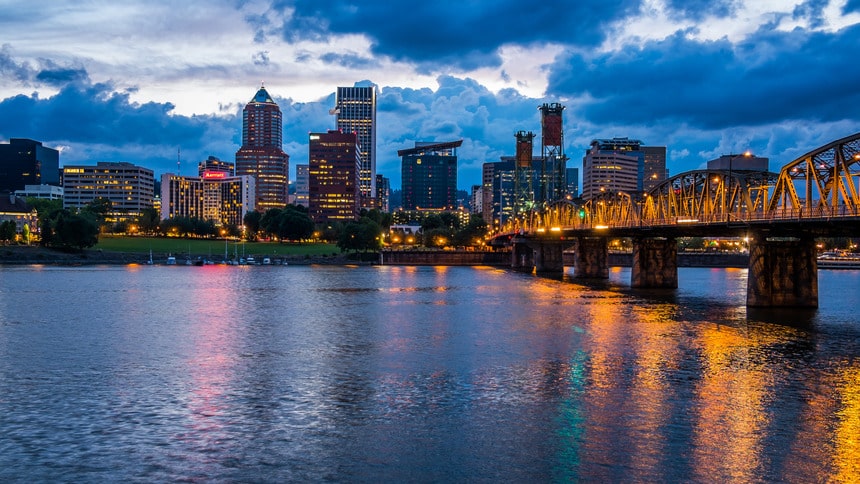
- Cloudy Days: 222
- Partly Cloudy Days: 74
- Clear Days: 69
- Average Annual Temperature: 54.4°F
- Average Annual Number of 32°F or Lower Days: 38
- Average Annual Precipitation: 36.03 inches
Portland, Oregon, continues the Pacific Northwest’s dominance in spot number five with 222 cloudy days each year plus another 74 where the sun is at least partially interrupted. Portland is a bit farther inland than Seattle or Olympia, insulated slightly by the coastal mountain ranges that sit between the city and the Pacific Ocean. That’s one main reason why Portland isn’t quite as cloudy as its neighbors to the north. It’s also just that much farther from the storm track during the spring and fall when the jet stream and its associated cloudiness are retreating northward or slowly creeping southward, respectively.
Portland is known for its eclectic food and art scene and the Portland Japanese Garden, which features an impressive expanse of Japanese plants and waterfalls just minutes from downtown.
6. Kalispell, Montana
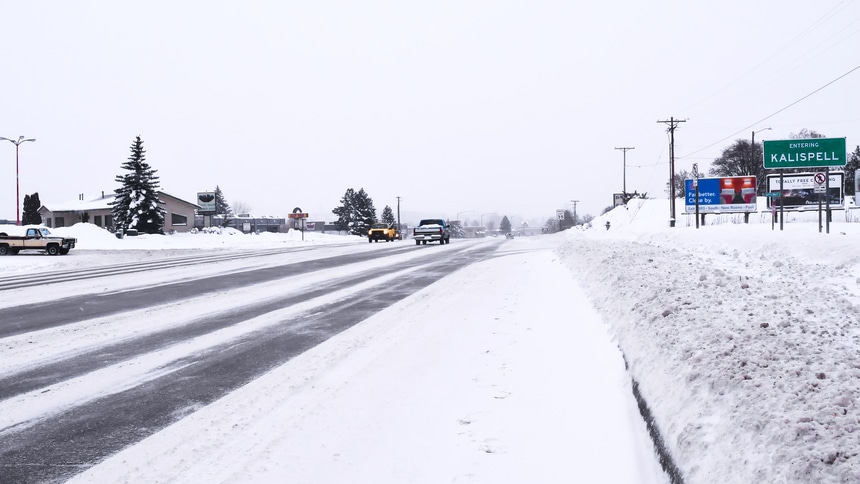
- Cloudy Days: 214
- Partly Cloudy Days: 81
- Clear Days: 70
- Average Annual Temperature: 43.3°F
- Average Annual Number of 32°F or Lower Days: 178
- Average Annual Precipitation: 16.99 inches
Still in the northwestern corner of the country but in quite a different landscape is Kalispell, Montana, a small(-ish) outpost in the state’s northwestern corner. Kalispell isn’t known for being as gloomy as the Pacific coast, and as it’s separated from the ocean by one formidable mountain chain (the Cascades), you might be surprised to see it on our list in spot number six. That said, it still posts 214 cloudy days on average each year, with 81 more days under partly cloudy skies.
How does it manage such a feat while sitting in a high semi-arid climate? After all, the city only sees 17 inches of rain each year on average! The answer lies in the geography around Kalispell. It is surrounded on all sides by mountains but is in a valley too shallow and narrow to experience the downsloping that keeps clear skies semi-permanently parked over a city like Reno, Nevada, for instance (downwind of the Sierra Nevada).
Remember that downsloping is the term meteorologists give to the warming and drying effect produced by air descending a mountain. This effect can be drastic, but it’s tempered a bit in Kalispell because whatever air is forced to descend the mountains to its west is immediately forced to rise back up the mountains to its east (prevailing winds in Kalispell are from the west, which helps bring Pacific moisture towards the city). Kalispell’s narrow valley helps keep it from being especially rainy but doesn’t do much to help with the cloudiness that comes from sitting downwind of the Pacific.
Kalispell is best known for being the gateway to Glacier National Park and a vast array of other public land nearby, providing world-class hiking, fishing, biking, and other recreation opportunities.
7. Binghamton, New York
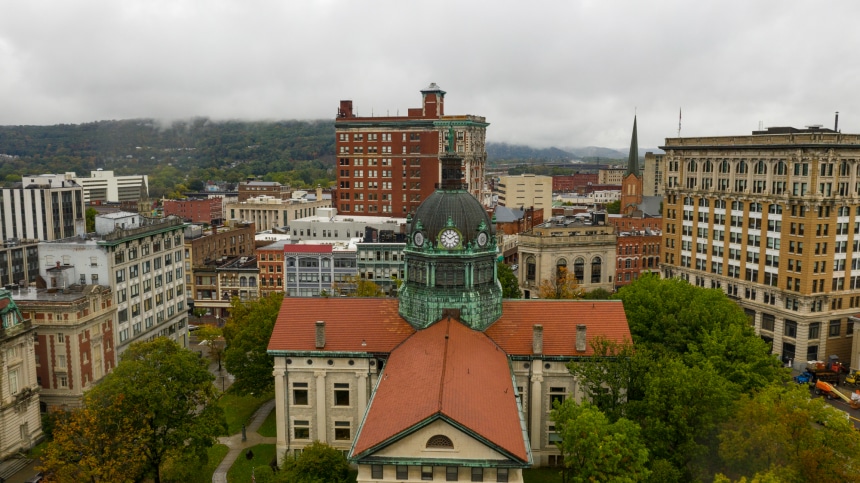
- Cloudy Days: 212
- Partly Cloudy Days: 102
- Clear Days: 51
- Average Annual Temperature: 46.2°F
- Average Annual Number of 32°F or Lower Days: 144
- Average Annual Precipitation: 39.30 inches
Our first entry from east of the Mississippi is Binghamton, New York. Located in the south-central part of the state near the Finger Lakes, Binghamton might not seem like the most obvious candidate for cloudy weather. That said, the city is still one of the cloudiest cities in America, with 212 cloudy days each year and another 102 at least partly cloudy. How does it rack up so many days of cloud cover?
The answers sit about 100 miles north and 150 miles west of the city: Lake Ontario and Lake Erie. During the winter, cold air from Canada moves across the still-warm lakes to produce a thick layer of clouds (frequently accompanied by rain and/or snow).
Warm air is less dense than cold air and will rise if located beneath colder air. When cold air masses come south out of Canada in the winter, a small layer of warm air adjacent to the Great Lakes is trapped beneath a much colder blanket of air coming in from the north. This warm air, rich with moisture due to evaporation from the lakes, then rises (warm air is less dense than the surrounding cold air). As it rises, the lake air cools, which means it can hold less moisture, and any excess must condense into cloud droplets (before, sometimes, falling out of the sky in the form of rain or snow).
Lake effect rain, snow, and clouds can last for days or even weeks on end! That’s why many of America’s rainiest cities are near the Great Lakes. Binghamton is the eighth-rainiest city in the country if you count by the number of days with precipitation (including snow)! It’s also the sixth-snowiest.
If lake-effect clouds are behind Binghamton’s impressive seventh-place showing, why wouldn’t a town like Syracuse (America’s fourth-rainiest and number-one snowiest city), rank more highly on this list of cloudiest cities? The answer comes during the summer months. When the Great Lakes are warmer than the surrounding air during the winter, they help supply moisture and instability to generate clouds and precipitation. In the summer, the land heats up much faster than water, and the lakes end up being cooler than their surroundings. Cool air, being more dense than warm air, is quite hesitant to rise and get even colder, which would enable clouds to form. As a result, Syracuse ends up being quite bright in the summer, while places farther south, like Binghamton, can rack up some more cloudy days as clouds bubble up in response to the daytime heating of the land.
Binghamton is home not just to cloudy weather but also to a fairly well-renowned zoo, the Binghamton Zoo at Rose Park. For those looking forward to more indoor-oriented activities in this city with often-gloomy weather, the Discovery Center of the Southern Tier is a great place to learn about the history of New York’s interior, and the Phelps Mansion Museum pays tribute to Binghamton’s gilded-age heyday.
8. Fairbanks, Alaska
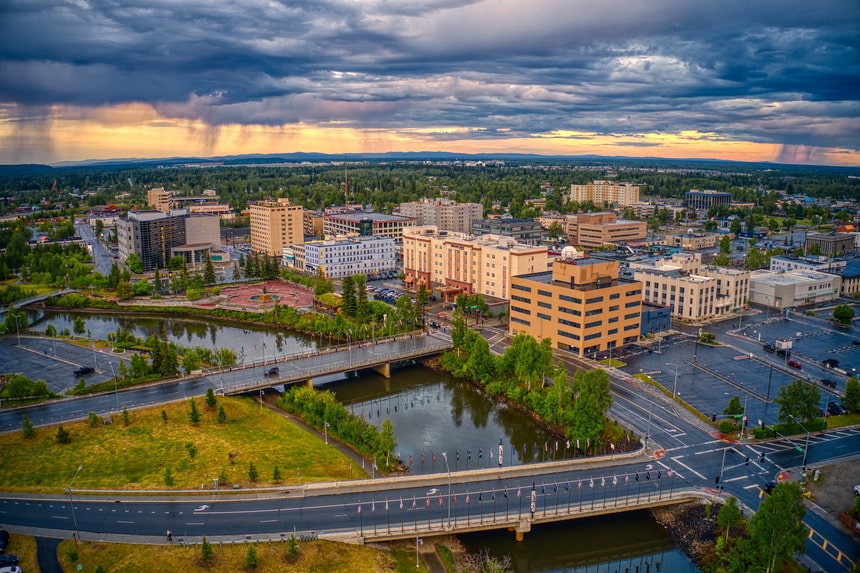
- Cloudy Days: 210
- Partly Cloudy Days: 86
- Clear Days: 69
- Average Annual Temperature: 27.6°F
- Average Annual Number of 32°F or Lower Days: 225
- Average Annual Precipitation: 10.81 inches
We’re heading back to Alaska for spot number eight, though unlike most of the cloudiest cities so far, Fairbanks is quite a distance from any body of water. It only averages 10.81 inches of precipitation each year, making it nearly a desert. How does it pile up so much cloudiness, then? 210 days of overcast skies plus 86 more days of at least partial cloud cover is impressive!
The answer lies partly in the city’s brutally cold temperatures. Fairbanks spends 225 days below freezing annually and is by far America’s coldest city and one of the coldest places in the world.
Remember that cold air can’t hold as much moisture as warm air, and when warm air cools off, any excess moisture that can no longer stay as water vapor (invisible to us) must condense into water droplets or ice crystals (visible to us as clouds). Because Fairbanks is so cold so often, it routinely gets fogged in as even the tiniest bit of moisture is forced out of the air by the cold temperatures. So while Fairbanks doesn’t pile up very much precipitation, it has lots and lots of foggy days that count as overcast for the purposes of our rankings.
With brutally cold temperatures dominating Fairbanks for most of the year, indoor activities are most popular here. The Museum of the North is a great place to learn about the history and culture of northern Alaska, while the Fountainhead Antique Auto Museum has a wide variety of historic cars and trucks. There are a couple of outdoor activities for hardy winter visitors, including Northern Lights viewing and dog sledding. Summer in Fairbanks can actually be pleasantly warm, and there are abundant opportunities for hiking, fishing, and biking in the vast wilderness surrounding the city.
9. Eugene, Oregon
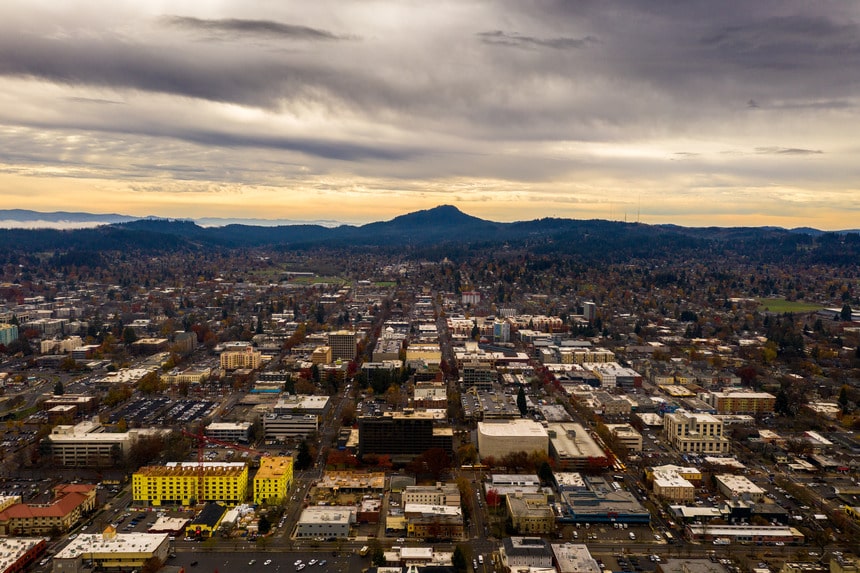
- Cloudy Days: 209
- Partly Cloudy Days: 82
- Clear Days: 74
- Average Annual Temperature: 52.4°F
- Average Annual Number of 32°F or Lower Days: 54
- Average Annual Precipitation: 46.10 inches
Back in the Lower 48, Eugene, Oregon, takes spot number nine with an average of 209 overcast days each year. Just a few miles down the scenic Willamette Valley from Portland, Eugene benefits from the same forces that bring the Rose City so much overcast. It’s close to the Pacific Ocean and the Cascade Mountains, which help turn invisible airborne moisture into highly-visible cloud droplets.
Eugene’s Museum of Natural and Cultural History is a great place to learn about the history of the Pacific Northwest and its inhabitants, and the Jordan Schnitzer Museum of Art has an extensive collection of works, especially from Asia.
10. Buffalo, New York
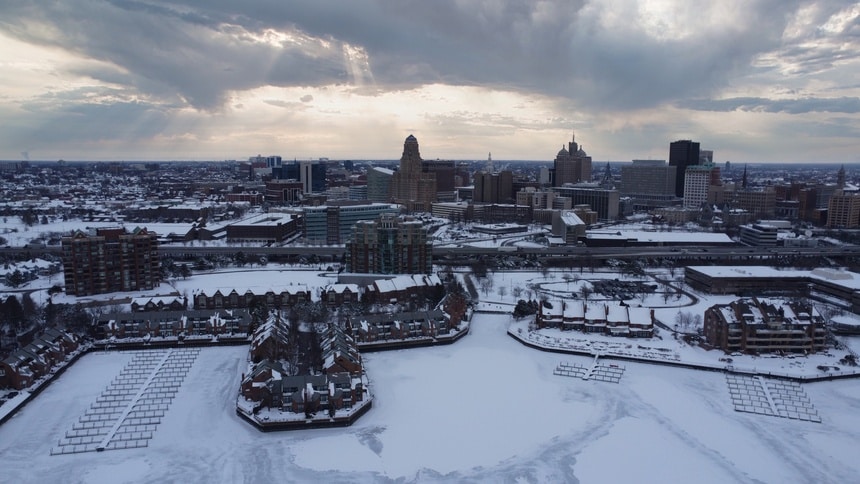
- Cloudy Days: 208
- Partly Cloudy Days: 103
- Clear Days: 54
- Average Annual Temperature: 48.2°F
- Average Annual Number of 32°F or Lower Days: 129
- Average Annual Precipitation: 40.48 inches
Another lake effect city, perhaps the most notorious for epic lake effect blizzards, takes spot number ten with 208 cloudy days each year. Nearby Lake Erie brings Buffalo long stretches of cloudy weather and, quite often, heavy snow during the winter. During the early summer, Lake Erie keeps Buffalo a bit brighter than surrounding inland towns, but because Lake Erie is shallower than Lake Ontario, it can warm up much faster during the summer. As a result, it becomes less of a cloud shield by mid-summer, which allows Buffalo to sneak into our top eleven list while other Lake Effect cities like Syracuse and Rochester miss out.
Buffalo’s top tourist attraction is nearby Niagara Falls, just a few miles northwest of the city. There are also a variety of historic homes and museums in the city proper if that’s more up your alley.
11. Missoula, Montana
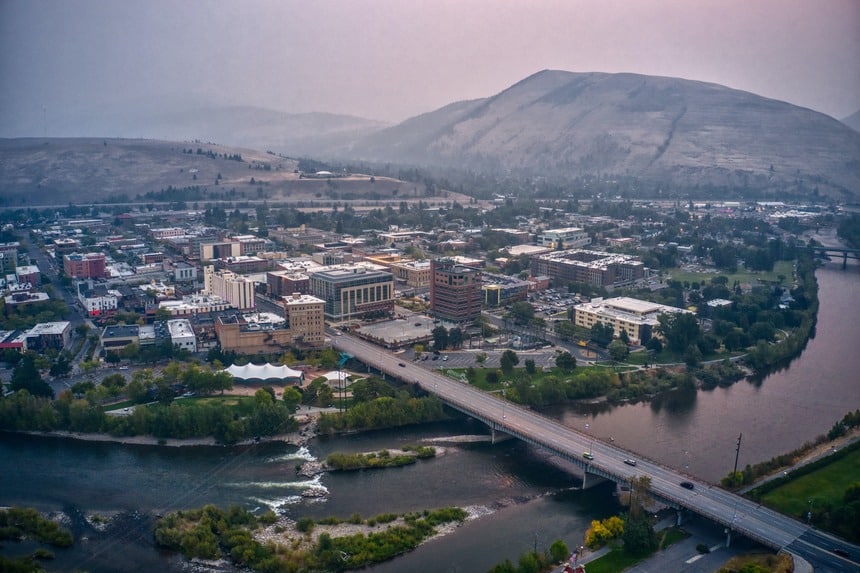
- Cloudy Days: 208
- Partly Cloudy Days: 83
- Clear Days: 74
- Average Annual Temperature: 45.9°F
- Average Annual Number of 32°F or Lower Days: 179
- Average Annual Precipitation: 14.13 inches
Last on our list is another entry from the Northern Rockies: Missoula, Montana. Located in another small valley just south of Kalispell, Missoula benefits from the same Pacific storm track and lack of extreme local downsloping. With 208 cloudy days, it matches Buffalo’s total, but it has fewer days of partial cloud cover and more clear days, so we’ve put it in eleventh place on our rankings. In the summer, Missoula is often very bright as high pressure settles in over the Rockies.
Missoula is an extremely popular destination for hiking, mountain biking, fly fishing, and whitewater rafting, as it sits at the gateway to vast tracts of wilderness in northwestern Montana and northeastern Idaho.
Honorable Mention: Cold Bay, Alaska
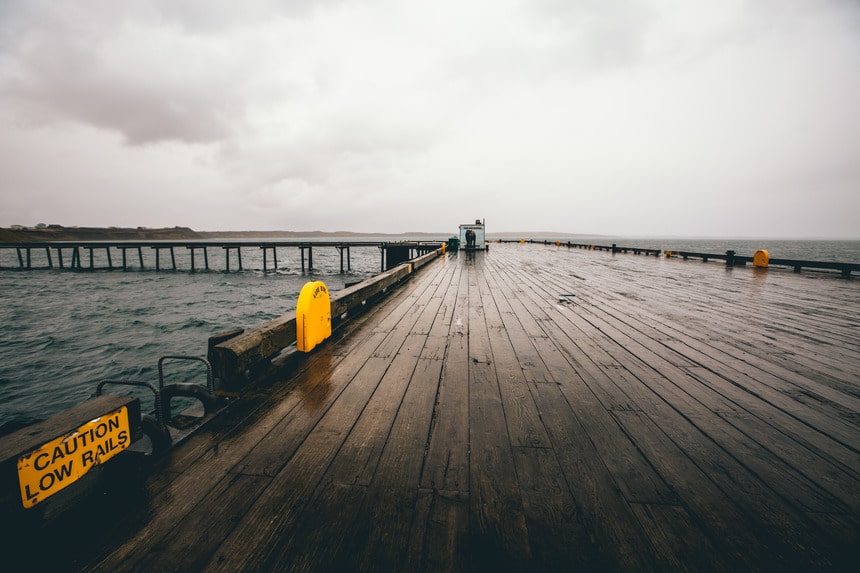
With 304 days of cloud cover, Cold Bay, Alaska, is the cloudiest place in the US overall, but it doesn’t meet our population cut-off, with just 50 permanent residents as of the 2020 census. Cold Bay is located in the Aleutian Islands, which extend southwest from mainland Alaska.
The Aleutians are among the cloudiest places in the world as moisture from across the Pacific crashes into frigid water seeping south from the Arctic Ocean through the Bering Strait. Cold Bay is also among the nation’s rainiest outposts, with 236 days on average recording more than 0.01” of precipitation. Sitting at the end of the Western Pacific storm track, Cold Bay and the Aleutians are frequently rocked by violent storms coming either off Japan or out of the tropical Western Pacific. Hurricane-force wind gusts are common, as are towering ocean waves. No wonder this area is home to a number of popular TV shows, such as Deadliest Catch, that follow the harrowing journeys of commercial fishermen!
If you never want to worry about sunburns again and are happy spending most of your days huddled in one of the town’s small cabins while storms rage outside, Cold Bay could be the place for you.
Final Thoughts
Clouds need moist air to cool off in order to develop, and all of our top eleven cloudiest cities have moisture nearby and some way to get that moisture to cool and condense into clouds. The Pacific Ocean is the most effective source of both ingredients for clouds, as we’ve seen by how many of our cloudiest cities sit on or near the Pacific coast from Oregon up to Alaska. That said, New York snuck a couple of cities onto the list thanks to the Great Lakes and the lake effect they provide during the winter.
Many of us associate clouds with cold temperatures and precipitation. This is a reasonable association to make as many of our cloudiest cities also earn spots on our list of coldest, rainiest, and/or snowiest US cities. It’s not a perfect relationship, though, as different types of clouds can signal quiet weather or an incoming storm. Mild cities such as Seattle, Portland, Oregon, and Eugene are also quite cloudy. Some of our cloudiest cities, including Kalispell and Missoula in Montana and Fairbanks in Alaska, record very little precipitation. However, none of our cloudiest cities are on our list of hottest US cities. You can stay fairly warm under thick clouds, but recording extremely hot temperatures without plenty of sunshine is nearly impossible.
This list is compiled using data from the National Centers for Environmental Information’s Comparative Climatic Dataset. This dataset uses information spanning from the late 1940s or early 1950s (depending on the station) until 2020, ensuring a long period of reliable data with which to make comparisons.


